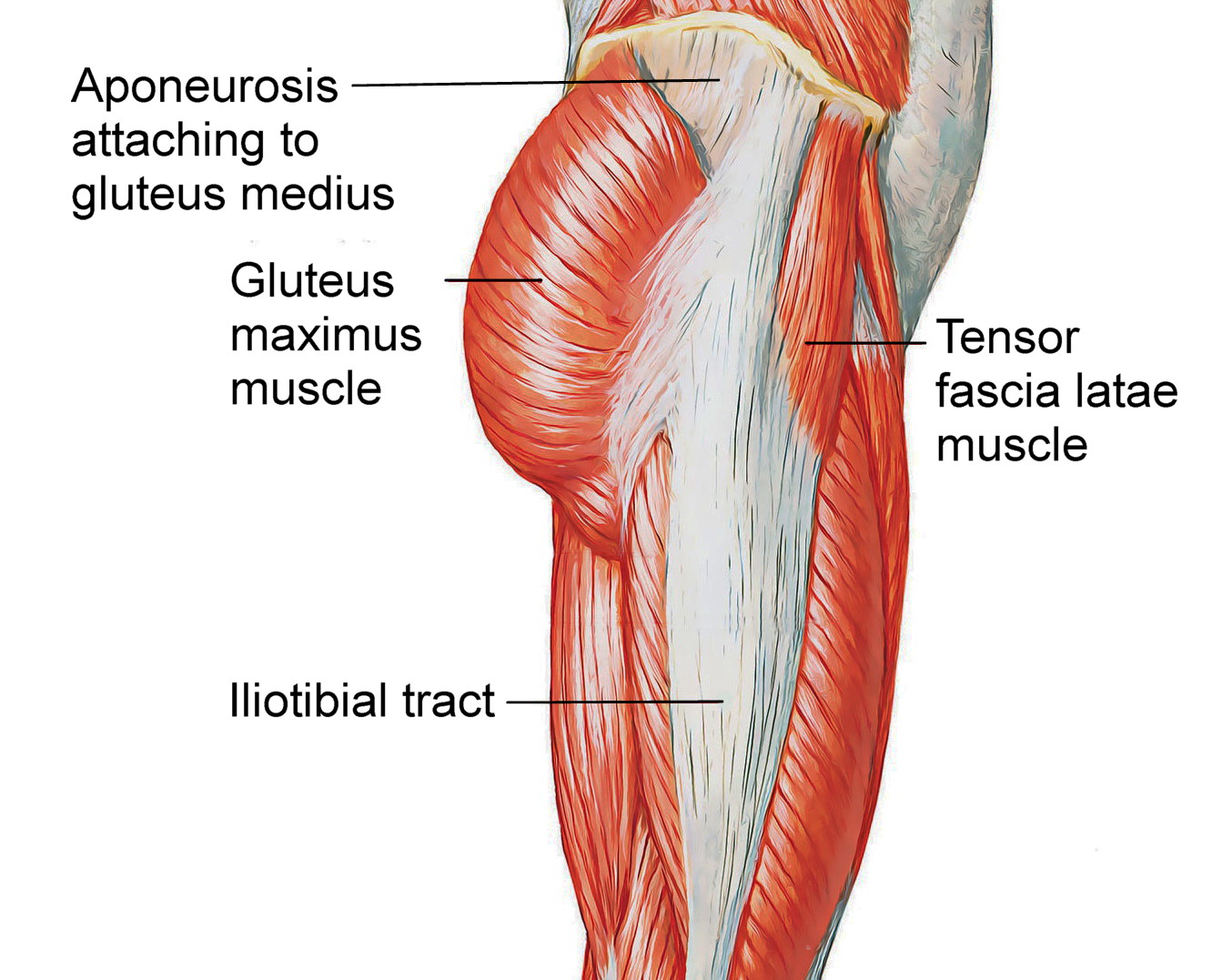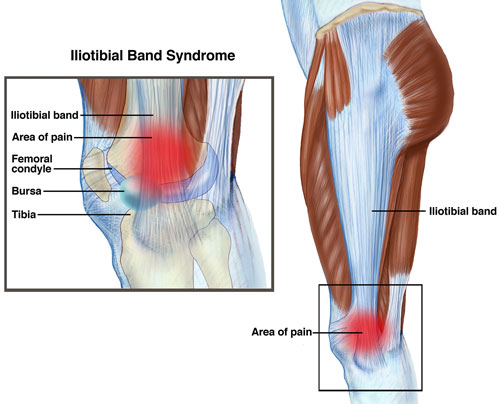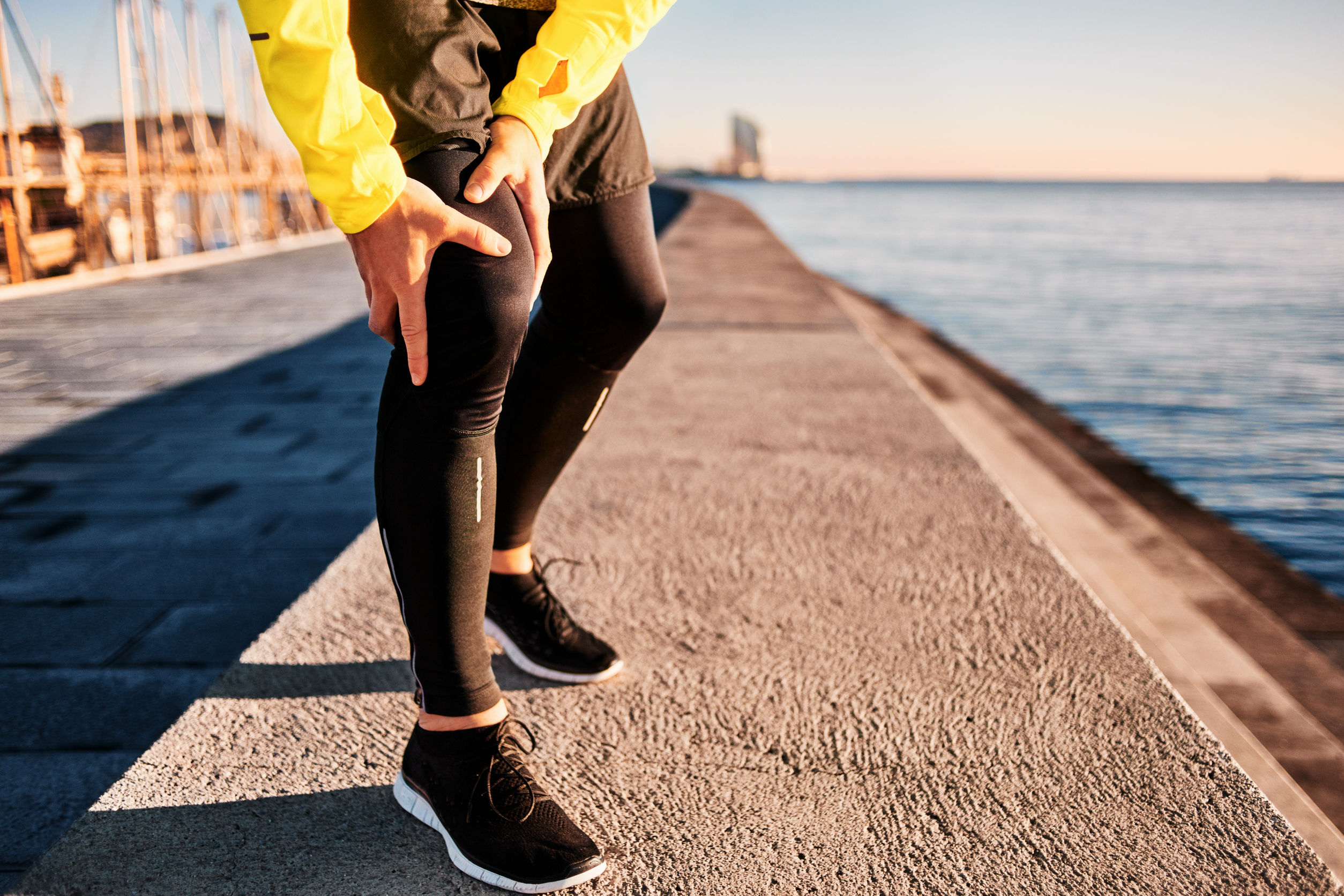Pourquoi les étirements ne soulagent pas le syndrome de la bandelette de Maissiat
Le syndrome de la bande iliotibiale est une affection inflammatoire douloureuse de l'articulation du genou qui touche souvent les coureurs, les randonneurs et les cyclistes. L'étirement est généralement recommandé pour allonger la bande iliotibiale et soulager la condition, mais comme vous l'apprendrez dans cet article, l'étirement statique a peu ou pas d'effet durable sur la longueur de la bande iliotibiale.
Read on to learn why pandiculation is the most effective way to release chronic tension in the iliotibial band and change habitual posture and movement patterns that may be contributing to the condition.
Qu'est-ce que la bande iliotibiale ?
La bande iliotibiale (bande IT, ITB) ou tractus iliotibial est une longue bande épaisse de tissu fibreux. La bande IT commence à la hanche et descend à l'extérieur de la cuisse, se fixant sous l'articulation du genou sur le bord extérieur du tibia (tibia).
La bande IT est composée principalement de fibres de collagène densément emballées disposées en lignes droites, ce qui lui confère une grande résistance à la traction. Le tissu contient également des protéines d'élastine, qui lui confèrent une certaine élasticité. La bande IT offre une stabilisation importante du genou pendant le mouvement.
As you can see in the diagram, the IT band is connected to three muscles: the tensor fascia latae, the gluteus maximus, and the gluteus medius (through an aponeurosis, a flat fibrotendinous tissue). Tightness in any of these three muscles will pull on the IT band, making it taut.

Qu'est-ce que le syndrome de la bande iliotibiale ?
Le syndrome de la bande iliotibiale (syndrome ITB, ITBS) fait référence à une douleur inflammatoire ressentie au niveau de la partie latérale (externe) du genou à la suite d'une surutilisation. La douleur peut commencer par une sensation de piqûre ou de picotement. Certaines personnes peuvent également ressentir de la douleur au-dessus ou au-dessous du genou, ou de l'extérieur de la cuisse à la hanche.
Typically, the IT band glides smoothly over the lateral femoral epicondyle when the knee is flexed and extended. But if the IT band is tight and then becomes overused, the friction created during movement of the knee joint can lead to painful inflammation of the IT band.
Certaines personnes atteintes du syndrome de la bande iliotibiale peuvent ressentir un claquement ou un claquement au genou lorsqu'elles le fléchissent et l'étendent. Au fur et à mesure que le syndrome de la bande iliotibiale progresse, les personnes peuvent ressentir une douleur extrême en marchant, en montant et en descendant les escaliers et chaque fois que leur talon touche le sol.

Qu'est-ce qui cause le syndrome de la bande iliotibiale?
Several factors affect whether or not someone will get iliotibial band syndrome. The first is having a tight iliotibial band. As mentioned above, chronic tightness in any or all three of the muscles that attach to the IT band—the tensor fascia latae, the gluteus maximus, and the gluteus medius—will pull on the IT band, making it taut.
The second factor is overuse. When the IT band is pulled taut due to muscle tension and it is then overused, ITB syndrome can easily occur. The most common cause of overuse is athletic training that involves repeated flexing and extending of the knees, like running, hiking, cycling, and playing soccer.
The third factor in developing iliotibial band syndrome is having an imbalance in posture or movement. Functional leg length discrepancy, overpronation of the feet, and bowleggedness are all associated with increased risk of ITB syndrome. Likewise, running on a horizontally banked surface, like the shoulder of a road or an indoor track, stretches the IT band against the lateral femoral epicondyle of the downhill leg and can cause ITB syndrome.
Sortir de la douleur : Comment soulager le syndrome de la bande iliotibiale
Si vous essayez de guérir du syndrome ITB, vous devrez vous attaquer aux trois facteurs qui y jouent un rôle.
First, you should reduce or take a break altogether from the activity that is overusing your knee joint in order to allow the inflammation to subside. While it can be difficult to take time off from an activity that you love, you must give your body a chance to heal—otherwise you will continue to make your pain worse, and potentially cause permanent damage to your knee joint.
Au fur et à mesure que vous reprenez une activité physique, je recommande fortement l'entraînement croisé : faire deux, trois ou plusieurs types d'entraînements différents qui utilisent votre corps de différentes manières (comme la course, la natation et le yoga). Le cross-training est le meilleur moyen d'atteindre un haut niveau de forme physique tout en évitant les blessures répétitives.
Second, you must address the chronic tension in the muscles that attach to your IT band. This is why static stretching is often recommended to relieve ITB syndrome. Unfortunately, due to the stretch reflex (myotatic reflex), static stretching will have little to no effect on the level of tension in these muscles. If you’re not familiar with the stretch reflex, be sure to read What is the Stretch Reflex (Myotatic Reflex)?
In order to release the chronic tension in the tensor fascia latae, gluteus maximus, and gluteus medius, you must pandiculate them. Pandiculation contracts and releases muscles in a specific way so that accurate biofeedback is sent to the nervous system, allowing the resting level of tension in the muscles to be reset.
Pandiculation also addresses the third factor in ITB syndrome: imbalanced posture and movement patterns. Imbalanced use of the body is caused simply by muscle memory. As we repeat certain postures and movements over and over, our nervous system gradually makes the muscular contraction involved in these patterns automatic. This is why people who spend long hours at a computer develop rounded posture, and why weightlifters have tight lower backs; it’s all the result of muscle memory. If you’d like to learn more about this topic, check out Le Secret du Soulagement de la Douleur.
En utilisant Somatiques Cliniques exercices pour soulager le syndrome de la bande iliotibiale
Formation Somatique Clinique est une méthode d'éducation neuromusculaire développée par Thomas Hanna. Hanna a créé de nombreux exercices d'auto-soins qui utilisent sa technique de pandiculation pour relâcher les tensions musculaires chroniques involontaires et recycler le système nerveux.
You can learn Clinical Somatics exercises in the online Level One & Two Courses. These two courses together include all 40 exercises that I teach, allowing you to thoroughly address the muscle tension and imbalances throughout your body.
The following exercises from the Level One & Two Courses are the most effective exercises for releasing the tight muscles that cause mechanical back pain.
If you want more guidance on how to improve your posture, please read Comment recycler votre proprioception et votre posture.
Cours de Niveau Un
Arch & Flatten: This exercise allows you to release and regain control of the lower back and abdominal muscles, improving the alignment of the pelvis and lower back.
Back Lift: This exercise is practiced lying on the stomach, allowing you to most effectively pandiculate the muscles on the back side of your body, from your shoulders to your lower back and gluteals.
Side Curl: This exercise is important for everyone to do, especially if you have IT band pain more on one side than the other. This exercise releases the obliques and quadratus lumborum, which can hike one hip up, causing functional leg length discrepancy.
One-Sided Arch & Curl and Diagonal Arch & Curl: These exercises release the lower back and abdominal muscles. They focus on one side of your body at a time, allowing you to address imbalances in your muscular patterns.
Iliopsoas Release: This is an important exercise for everyone to do regularly, especially if you have tension or pain in your lower body.
Hip Rotation: This exercise releases the internal and external hip rotators, which are nearly always tight in cases of IT band pain.
Hamstring Release: Tight hamstrings often go along IT band tension and pain, so this is an important exercise to do daily.
Cours de Niveau Deux
Quadriceps Releases: Many people with IT band syndrome have chronic tension in all of their leg muscles – often from intense athletic training – and it’s important to release tension throughout the legs in order to fully address the problem.
Gluteal Release: This exercise works directly with releasing the glutes, which are tight in IT band syndrome.
Iliotibial Band Release: While you may have to be patient to get to this exercise in the course, you may have already felt complete relief at this point by having addressed tension in the core of your body and other leg muscles.
Calf Release: Many people with IT band syndrome spend a lot of time on their feet, and likely have tension in their calf muscles.
Standing Hamstring Release: This exercise is an intense hamstring release, and should only be practiced after becoming comfortable with all of the previous exercises for the legs and lower back.
Exercice Proprioceptif 2
Lecture recommandée:
The Pain Relief Secret: How to Retrain Your Nervous System, Heal Your Body, and Overcome Chronic Pain by Sarah Warren, CSE
Somatics: Reawakening the Mind’s Control of Movement, Flexibility and Health by Thomas Hanna

